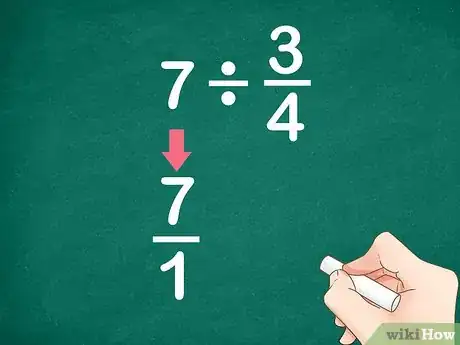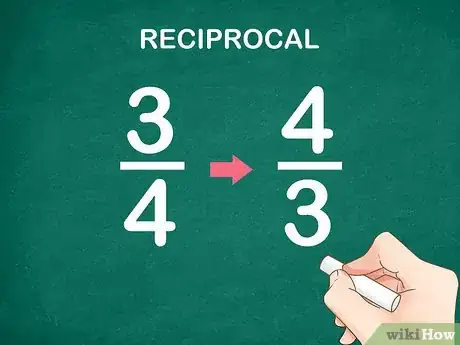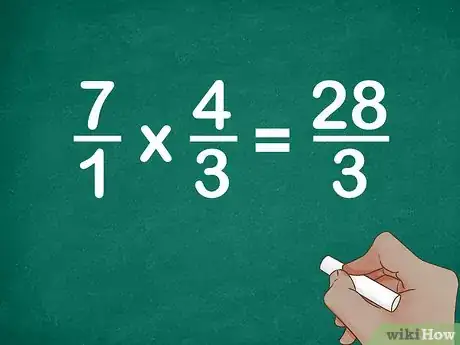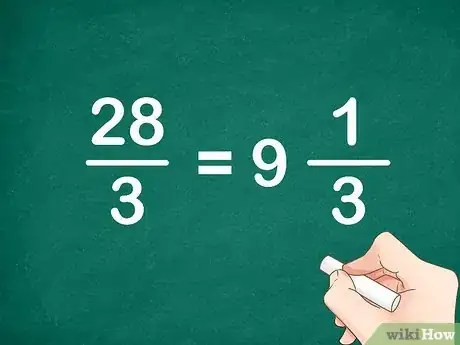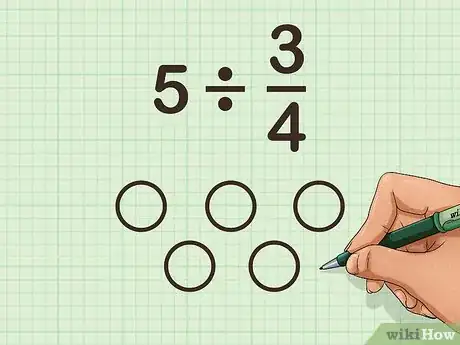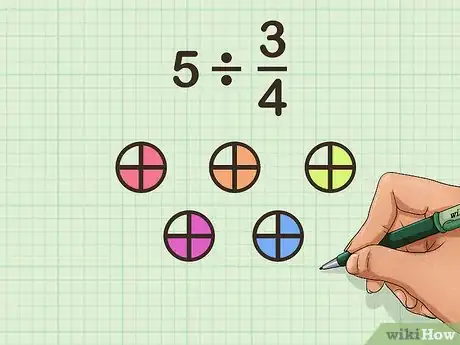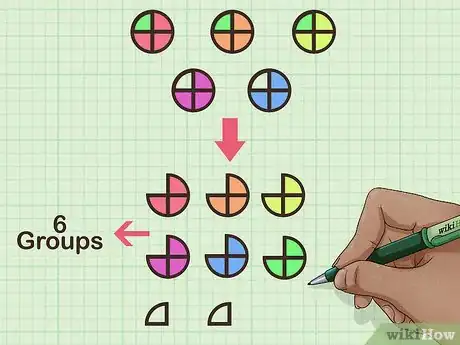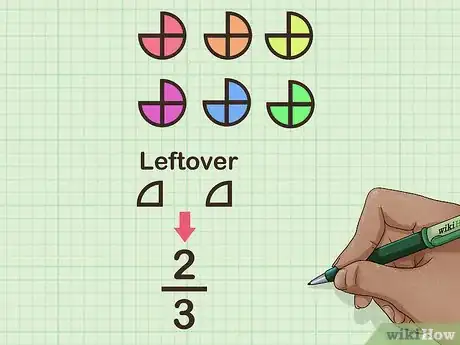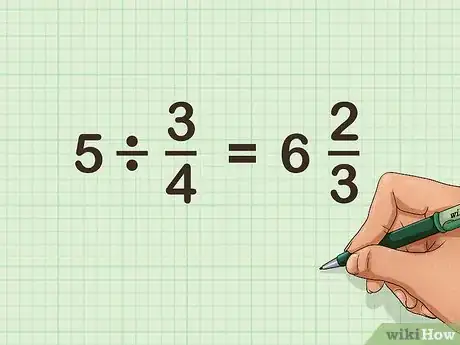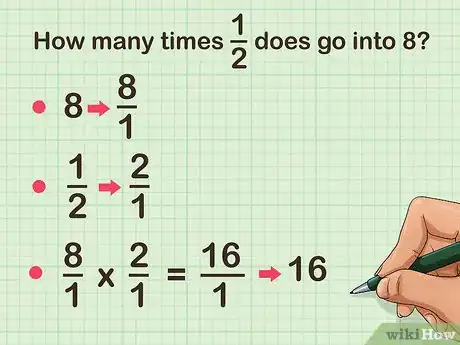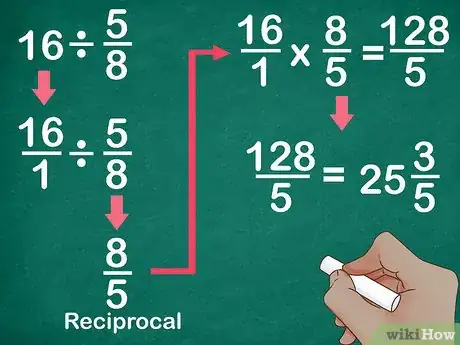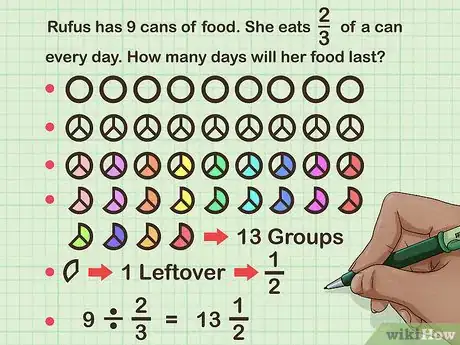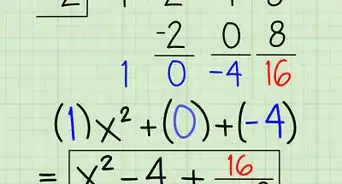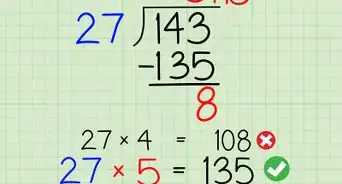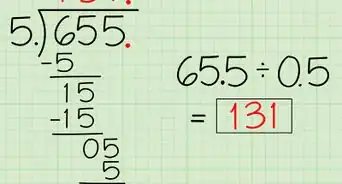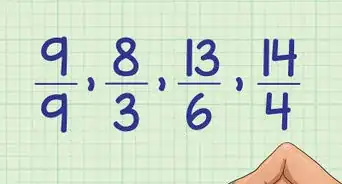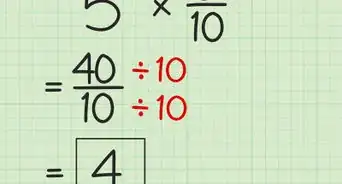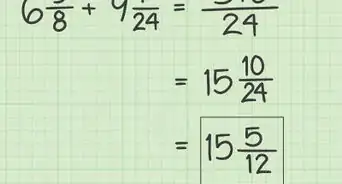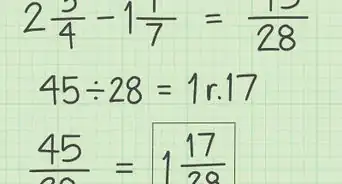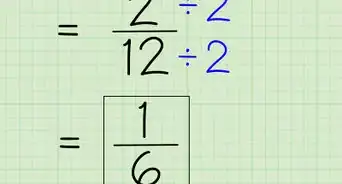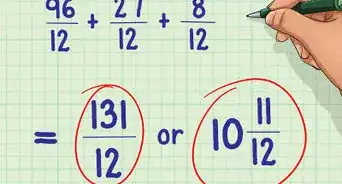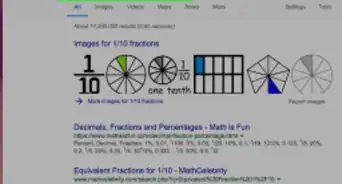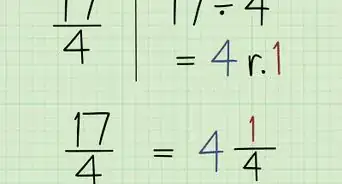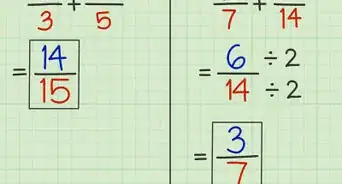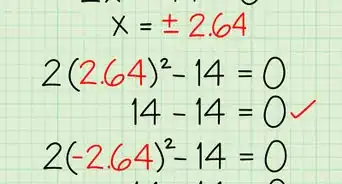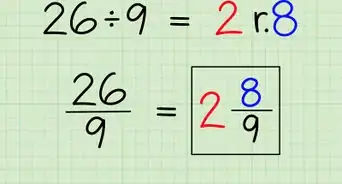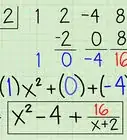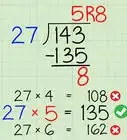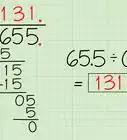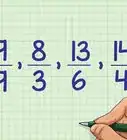This article was co-authored by wikiHow Staff. Our trained team of editors and researchers validate articles for accuracy and comprehensiveness. wikiHow's Content Management Team carefully monitors the work from our editorial staff to ensure that each article is backed by trusted research and meets our high quality standards.
There are 7 references cited in this article, which can be found at the bottom of the page.
This article has been viewed 248,832 times.
Learn more...
When dividing a whole number by a fraction, you are finding how many groups of the fraction you can fit in the whole. The standard way of dividing a whole number by a fraction is to multiply the whole number by the reciprocal of the fraction. You can also draw a diagram to help you visualize the process.
Steps
Multiplying by the Reciprocal
-
1Convert the whole number to a fraction. To do this, make the whole number the numerator of a fraction. Make the denominator 1.[1]
- For example, if you are calculating , you would first change to Failed to parse (MathML if possible (experimental): Invalid response ("Math extension cannot connect to Restbase.") from server "https://wikimedia.org/api/rest_v1/":): {\frac {7}{1}} .
-
2Find the reciprocal of the divisor. The reciprocal of a number is the inverse of the number. To find the reciprocal of a fraction, reverse the numerator and denominator.[2]
- For example, the inverse of is .
Advertisement -
3Multiply the two fractions. To multiply fractions, first multiply the numerators together. Then, multiply the denominators together. The product of the two fractions equals the quotient of your original division problem.[3]
- For example,
-
4Simplify, if necessary. If you have an improper fraction (a fraction with a larger numerator than denominator), your teacher may require you to change it to a mixed number. Usually your teacher will require you to reduce proper fractions to lowest terms.[4]
- For example, simplifies to the mixed number .
Drawing a Diagram
-
1Draw shapes representing the whole number. Your shape should be one capable of dividing into equal groups, such as a square or circle. Draw the shapes large enough that you can divide them into smaller pieces.
- For example, if you are calculating , you would draw 5 circles.
-
2Divide each whole shape according to the fraction’s denominator. The denominator of a fraction tells you how many pieces a whole is divided into. Divide each whole shape into its fractional parts.[5]
- For example, if you are dividing by , the 4 in the denominator tells you to divide each whole shape into fourths.
-
3Shade in groups representing the fraction. Since you are dividing the whole number by the fraction, you are looking to see how many groups of the fraction are in the whole number.[6] So, first, you need to create your groups. It might be helpful to shade each group a different color, since some groups will have pieces in two different wholes. Leave any leftover pieces unshaded.
- For example, if you are dividing 5 by , you would color 3 quarters a different color for each group. Note that many groups will contain 2 quarters in one whole, and 1 quarter in another whole.
-
4Count the number of whole groups. This will give you the whole number of your answer.
- For example, you should have created 6 groups of among your 5 circles.
-
5Interpret leftover pieces. Compare the number of pieces you have left over to a complete group. The fraction of a group that you have left over will indicate the fraction of your answer. Make sure you do not compare the number of pieces you have to a whole shape, as this will give you the wrong fraction.[7]
- For example, after dividing the 5 shapes into groups of , you have 2 quarters, or left. Since a whole group is 3 pieces, and you have 2 pieces, your fraction is .
-
6Write the answer. Combine your whole number of groups with your fractional number of groups to find the quotient of your original division problem.[8]
- For example, .
Solving Sample Problems
-
1Solve this math problem: How many times does go into ?
- Since the problem is asking how many groups of are in 8, the problem is one of division.
- Turn 8 into a fraction by placing it over 1: .
- Find the reciprocal of the fraction by reversing the numerator and denominator: becomes .
- Multiply the two fractions together: .
- Simplify, if necessary: .
-
2Solve the following problem: .
- Convert 16 into a fraction by placing it over 1: .
- Take the fraction’s reciprocal by reversing the numerator and denominator: becomes .
- Multiply the two fractions together: .
- Simplify, if necessary: .
-
3Solve the following problem by drawing a diagram. Rufus has 9 cans of food. She eats of a can every day. How many days will her food last?
- Draw 9 circles representing the 9 cans.
- Since she eats at a time, divide each circle into thirds.
- Color groups of .
- Count the number of complete groups. There should be 13.
- Interpret the leftover pieces. There is 1 piece leftover, which is . Since a whole group is , you have half a group left over. So, your fraction is .
- Combine the number of whole groups and fractional groups to find your final answer: .
Community Q&A
-
QuestionWhat is 12 3/7 divided by 9?
 DonaganTop AnswererFirst convert 12 3/7 to the improper fraction 87/7. Then divide by 9. The easiest way to do that is to multiply the denominator by 9: 7 x 9 = 63. So 87/7 ÷ 9 = 87/63, which reduces to 29/21. If you want the answer in mixed-number form, it's 1 8/21.
DonaganTop AnswererFirst convert 12 3/7 to the improper fraction 87/7. Then divide by 9. The easiest way to do that is to multiply the denominator by 9: 7 x 9 = 63. So 87/7 ÷ 9 = 87/63, which reduces to 29/21. If you want the answer in mixed-number form, it's 1 8/21. -
QuestionHow do I will simplify 24/1?
 DonaganTop Answerer24/1 = 24.
DonaganTop Answerer24/1 = 24. -
QuestionHow do I divide 100,000 to 8 shares and 1/2 share?
 DonaganTop AnswererDivide 100,000 by 8.5.
DonaganTop AnswererDivide 100,000 by 8.5.
References
- ↑ http://www.virtualnerd.com/pre-algebra/rational-numbers/definitions-basics/convert-decimals-fractions/integer-to-fraction-conversion
- ↑ https://www.mathsisfun.com/reciprocal-fraction.html
- ↑ https://www.varsitytutors.com/hotmath/hotmath_help/topics/dividing-fractions
- ↑ https://www.calculatorsoup.com/calculators/math/fractionssimplify.php
- ↑ https://www.khanacademy.org/math/cc-fifth-grade-math/cc-5th-fractions-topic/tcc-5th-div-frac-whole-word-prob/v/dividing-a-whole-number-by-a-fraction-word-problem
- ↑ http://illinois.pbslearningmedia.org/resource/mgbh.math.nf.divfrac/dividing-a-whole-number-by-a-unit-fraction/
- ↑ https://www.mathsisfun.com/numbers/fractions-division-whole-numbers.html
- ↑ https://www.mathsisfun.com/numbers/fractions-division-whole-numbers.html
About This Article
To divide a whole number with a fraction, make the whole number into a fraction by putting it over a denominator of 1. Next, reverse the numerator and denominator of the fraction you’re dividing the whole number with. Multiply this new fraction and the whole number. To do this, multiply both of the numerators, then both of the denominators. If you need to, simplify the new result. Keep reading to learn how to divide a whole number into fractions by drawing a diagram!
